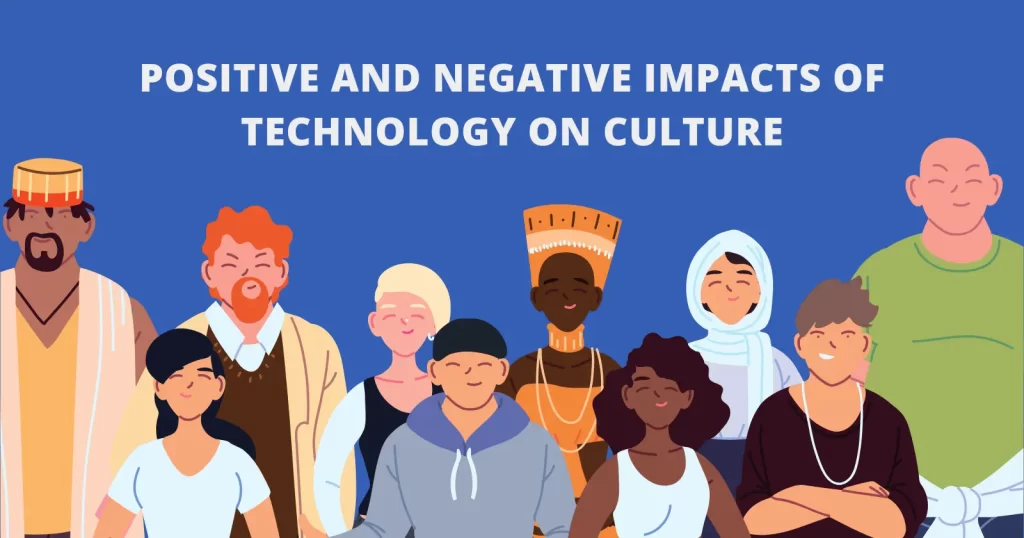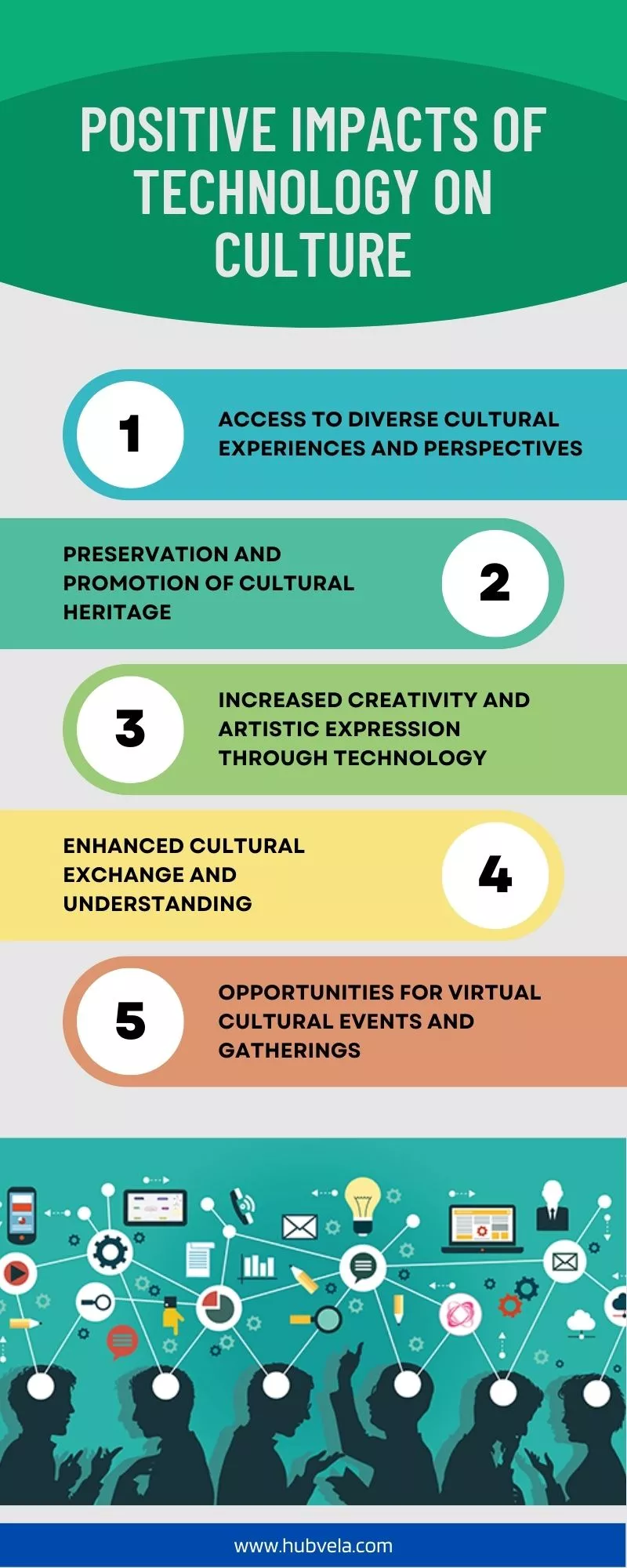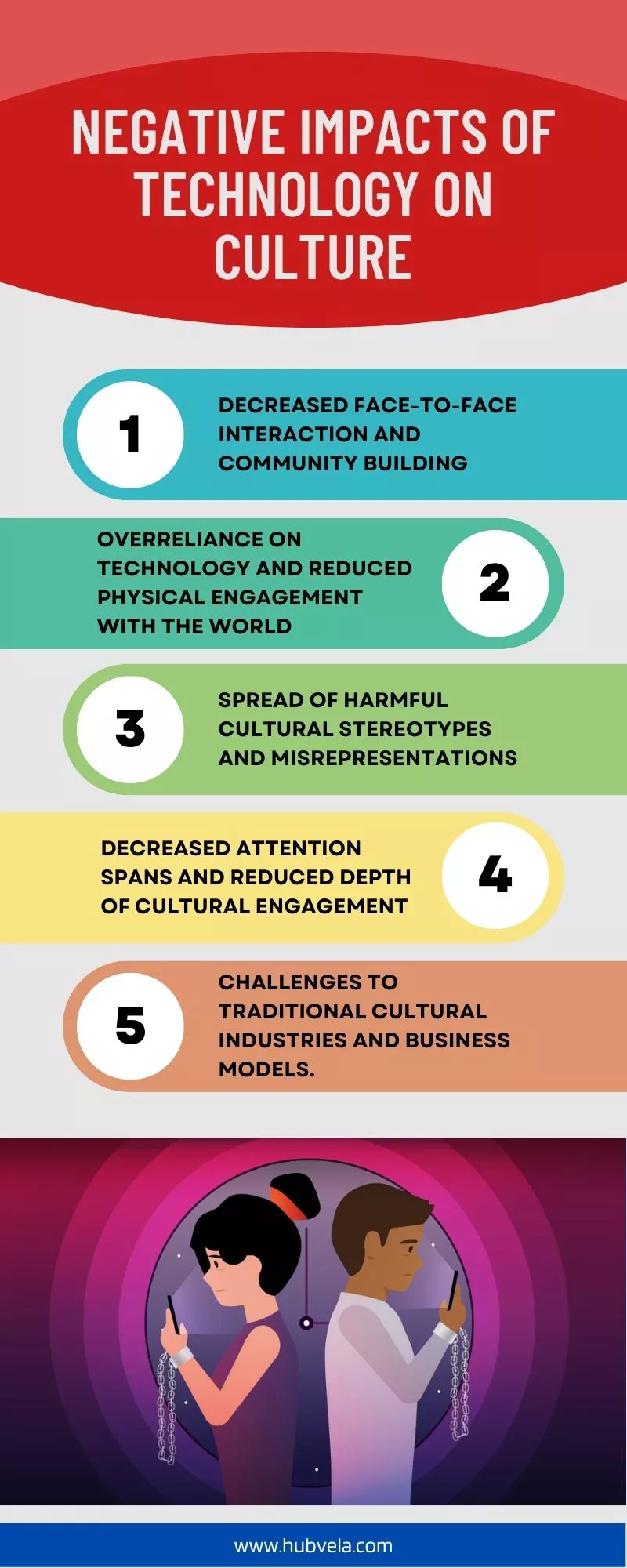Technology has become an integral part of our lives, and its impact on society is undeniable. The effects of technology on culture have been both positive and negative.
On the one hand, technology has helped societies raise productivity, and inclusivity of services, and improve overall well-being.
On the other hand, it has also influenced everyday life and had a strong influence on culture.
This article will explore the positive and negative impacts of technology on culture at local and global levels.

--Advertisement--
Positive Impacts of Technology on Culture
Technology has had a significant impact on various aspects of culture, including language, art, mobility, education, and religion.
With the dispersal of information through digital technology, cultures can view and interact with each other in new ways. Technology shapes different cultures and allows them to intermix.
It has influenced all demographic factors such as health, transportation, and electricity. However, some argue that technology is substituting human intellectual achievement with facile objects that make life easier.
Let’s discuss the major positive impacts of technology on culture.

1. Access to diverse cultural experiences and perspectives
Technology has had a positive impact on culture by providing access to diverse cultural experiences and perspectives.
With the help of technology, people can now easily connect with others from different cultures and learn about their traditions, language, art, mobility, education, and religion.
Digital technologies have also brought changes in contemporary Western societies. Technology has enabled media globalization which has helped in spreading cultural awareness globally.
Furthermore, multicultural education is important as it exposes students to various cultural and social groups, preparing them to become better citizens in their communities.
Therefore, technology has played a significant role in promoting cultural diversity and understanding.
2. Preservation and promotion of cultural heritage
Technology has had a positive impact on the preservation and promotion of cultural heritage. With the help of technology, cultural heritage restoration and preservation have become more efficient and effective.
Various technological elements have enabled the preservation, promotion, and dissemination of tangible and intangible cultural heritage.
Information technology can also serve as a tool to aid in the process of cultural heritage preservation.
UNESCO has been successful in preserving cultural heritage through various initiatives. However, it is important to note that technology should be used responsibly to ensure that it does not negatively impact culture, tradition, or social values.
3. Increased creativity and artistic expression through technology
Technology has had a positive impact on culture by increasing creativity and artistic expression. With the help of technology, artists can create immersive and interactive art pieces that were not possible before.
Technology has also allowed artists to experiment with new techniques and mediums, such as creating art through laser beams or data gathered from the environment.
Digital technologies have also promoted collaborative creativity by enabling communication and interaction between artists from different parts of the world.
Overall, technology has opened up new opportunities for artists to express themselves creatively and reach wider audiences.
4. Enhanced cultural exchange and understanding
Technology has had a significant impact on culture, including enhancing cultural exchange and understanding. With the rise of digital technologies, people from different cultures can now easily connect and share their experiences, beliefs, and traditions.
Technology has also made it easier to access cultural resources such as art, music, literature, and history.
Through social media platforms and other online tools, people can learn about different cultures and engage in cross-cultural conversations.
This increased cultural exchange can lead to a greater understanding and appreciation of diverse perspectives.
Overall, technology has played a positive role in promoting cultural exchange and understanding.
5. Opportunities for virtual cultural events and gatherings
The COVID-19 pandemic has accelerated the digitalization of cultural experiences, leading to new forms of cultural experiences through emerging technologies such as virtual and augmented realities.
Digital technologies have also introduced innovative ways for arts organizations to introduce new audiences to their work.
Virtual cultural events and gatherings provide better opportunities for understanding and respecting various cultures, which is essential for cultural awareness.
Technology has made the world a smaller place, presenting both barriers and opportunities for communication across cultures.
Overall, technology has opened up new avenues for people to experience different cultures and connect with others from around the world.
Negative Impacts of Technology on Culture:
Technology has had a profound impact on culture, both positive and negative. While it has brought about many benefits such as aiding research, healthcare, and education, it has also caused significant changes in cultural values and traditions.
The overemphasis on technology has created a lack of trust among people, and it can be blamed for unemployment and cultural lag.
Additionally, differences in location and economic class result in different levels of access to digital technology, leading to unequal impacts on local cultures.
It is important to consider both the positive and negative effects of technology on culture to ensure that we are using it responsibly.
Let’s discuss some of the negative impacts of technology on culture below

1. Decreased face-to-face interaction and community building
The increased use of technology has led to a decrease in face-to-face interaction and community building, which has negative impacts on culture.
Studies have shown that technology has a negative effect on both the quality and quantity of face-to-face communication.
Increased isolation, reduced social interaction and social skills, and increased human-to-machine interactions are all a result of an overuse of technology.
Technology is also leading to more sedentary lifestyles, which can contribute to obesity challenges.
As people rely more on technology to communicate, they may miss out on the benefits of in-person interactions such as building relationships and fostering a sense of community.
2. Overreliance on technology and reduced physical engagement with the world
Technology use has been linked to reduced physical activity levels, leading to sedentary behavior.
Additionally, excessive use of technology can lead to psychological and physical issues such as eyestrain and difficulty focusing on important tasks.
There are also concerns about the future well-being of people due to more isolation and less social interaction caused by technology.
Children are particularly vulnerable to the negative effects of technology, which can affect their physical health as well as their behavior.
Therefore, it is important to be mindful of our reliance on technology and strive for a balance between its benefits and drawbacks.
3. Spread of harmful cultural stereotypes and misrepresentations
Technology has contributed to the spread of harmful cultural stereotypes and misrepresentations.
Mass media, including social media and Hollywood movies, have been known to perpetuate negative stereotypes of ethnic, cultural, and religious identities.
The influence of stereotype threat on immigrants is also a concern. Cancel culture can also lead to the silencing of diverse voices and perspectives.
However, technology can also be used as a tool to combat these issues. For example, online problem-based learning lessons can help combat cultural stereotypes.
It is important for individuals and organizations to be aware of these negative impacts and work towards promoting diversity, equity, and inclusion in all aspects of technology use.
4. Decreased attention spans and reduced depth of cultural engagement
Technology has had negative impacts on culture, including decreased attention spans and reduced depth of cultural engagement.
Studies have shown that the collective global attention span is narrowing, and technology use can have either positive or negative effects on cognition, depending on the type of use.
Researchers have expressed concerns about shrinking attention spans. Additionally, technology has contributed to a culture with relatively low barriers to artistic expression and civic participation, but the inability to close this participation gap has negative consequences for everyone.
The trends suggest that technology may be contributing to a reduction in the depth of cultural engagement.
5. Challenges to traditional cultural industries and business models
The rise of technology has brought about significant challenges to traditional cultural industries and business models.
The COVID-19 pandemic has further exacerbated these challenges, with the cultural and creative sectors being hit particularly hard.
While innovation and creativity are at the core of art design, information technology is advancing rapidly, leading to Industry 5.0.
Digital technology presents both benefits and drawbacks for arts organizations. Studies have focused on the transformation of traditional business models or mechanisms underlying changes in employment due to technological advancements.
These challenges require a rethinking of traditional approaches to cultural industries and business models in order to adapt to the changing landscape.
Conclusion on the Positive and Negative Impacts of Technology on Culture
In conclusion, technology has both positive and negative impacts on culture. On the one hand, it has made it easier for people to connect and communicate globally, which can lead to greater cultural exchange and understanding. It has also improved research, healthcare, education, and other aspects of society.
On the other hand, technology can have negative effects on social values and traditions, particularly through mass-produced products like social media that can contribute to addiction and mental health issues. It is important to recognize both the benefits and drawbacks of technology in order to make informed decisions about its use in our lives.



I am grateful
I am happy to come accross such information.
Asking for the author or the source of this information. Once more thank you